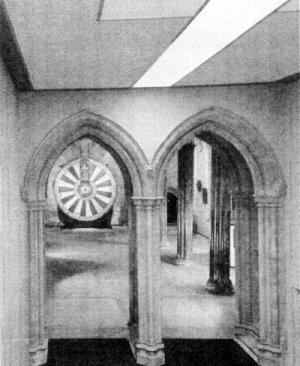The Royal Wedding Gates in the Great Hall - TrustNews July 17
“Winchester is the ancient capital of England and important tourist routes traverse the Westgate and Castle area. . . .Although the main attraction is the Cathedral, the Study Area contains the Castle Hall with the Round Table and this area will become increasingly attractive when the building is properly restored to its historical dignity and significance, the new Law Courts development is completed, and the recent important archaeological discoveries are displayed to their maximum advantage."
From the Winchester Westgate Study Donald lnsall and Associates 1970

When the above was written, the Great Hall had been in use as a Crown Court since 1937 when the Assize Court, designed by TH Wyatt (1807-80) in 1871, linked to the east end of the Great Hall by a pair of high pointed arches, suffered severe settlement and had to be demolished.
In its long history the Great Hall had, before the building of Wyatt’s Courts, been used for the holding of assizes, many of historic importance. It reverted to this use for the holding of assizes until 1973 when a major new building, designed by Louis de Soissons on the site of Wyatt’s courts was able to relieve it of this function.
Curved in plan, the axis of the new Law Courts sprang from the central axis of the Great Hall, and within it the .Judge‘s Gallery led down a broad flight of steps to Wyatt's two arches in the east wall of the Great Hall. These, for security reasons, were filled with blank partitioning doors.
On Maundy Thursday 1979, to make use of the Judge’s Gallery to accommodate the large number of guests invited to lunch with the Queen and Prince Phillip in the Great Hall after performing the ceremony in the Cathedral, these doors and the partitions had to be removed. The combination of the hall and the gallery seen together aroused much admiration and led to a demand for a secure solution to be found to enable both to be enjoyed as a visual entity. A suggestion to purchase wrought-iron gates from a specialist antique dealer had to be abandoned because the ‘openness’ of their design would not meet the Home Office’s security requirements.
An approach was then made to the Crafts Council about the possibility of having suitable gates made through the agency of the British Artist Blacksmith Association (BABA). On the Association's advice a limited competition was organized which led to the appointment of Anthony Robinson to construct two pairs of stainless steel gates which by happy coincidence could be identified with the forthcoming marriage of Prince Charles and Princess Diana and incorporate their initials and the year of their marriage in the gate’s design.
Following their installation the BABA Newsletter editorial declared ‘We have in this issue of British Blacksmith Anthony Robinson’s Winchester Gates article. They are a magnificent set of gates and probably the finest piece of artist blacksmithing in the world today.’

With the opening of the New Courts l became responsible for the clearing of the court furnishings and block of holding cells in the Great Hall and the restoration of its stained glass some of which was missing. And damage to the Table of the Knights of the Shire on the East wall needed repair. Both in the nineteenth century had been the work of the Birmingham firm of John Hardman which was found still to be in existence. From drawings it had deposited in the City of Birmingham Museum it was able to carry out the restoration work required.
Eventually, Castle Avenue and Castle Yard were cleared of car parking and were paved with York Stone and granite setts. The base of the Round Tower at the upper end of Castle Hill was repaired and its Sally Port made accessible to the public. Trees were planted at the upper end of Castle Hill and on the flight of steps leading from the Great Court up to the entrance of the new Law Courts. The latter in a battered circular base capped with a low parapet wall were given a wide coping, fortress-like in character.
